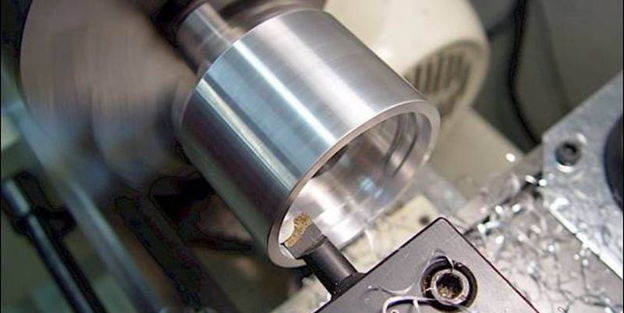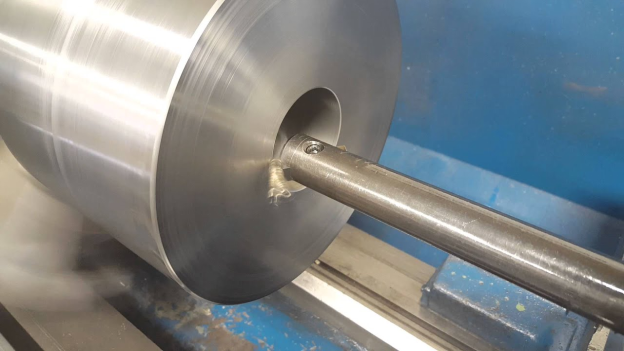Boring Machining: Boring Holes and Process
 Feb 11,2025
Feb 11,2025

You will have seen many applications in holes in the components that are important for making joints, fixing fasteners etc. These holes are created using drilling processes. But in case, you need to enlarge an existing hole or fix some misalignment in the internal diameter of the hole, what will you do? So, you will use this boring process to enlarge the existing holes. This article is a comprehensive guide to every aspect of the boring process in the manufacturing industry.
What is Boring Machining?
Let us provide you with a brief definition of the boring process:

Definition of Boring in Engineering and Manufacturing
Boring is a cutting technique in which you enlarge the existing holes, through drilling, etc., by removing the extra material. It's a simple concept: You operate the cutting tool to get the appropriate dimensions of the holes.
Difference Between Boring, Drilling, and Reaming
You will be confused about these terms; Boring, Drilling, and Reaming. So, let's make it clear:
- Drilling:A process used to create holes in the components
- Boring:You enlarge the existing holes
- Reaming:To get a better internal surface finish, choose the reaming process
Why is Boring Necessary in Machining?
Boring in the machining process, is important because you can:
- Enlarge existing holes
- Strengthen the holes
- To remove any casting defects
- To make countersinks
Advantages of Boring in Machining
You will see many advantages in machining, or you can say during preparing a component, like:
Achieving Precision and Accuracy
You will be amazed to see that a boring operation is precise and accurate, and it can provide you with precision and accuracy up to 0.0005 inches compared to drilling. Such accuracy enables us to produce parts with tight tolerances, which are used in critical components like automotive engines, etc.
Cost-Effectiveness and Efficiency
You can say that the boring process is cost-effective and efficient because when we use it for batch production, due to the high accuracy i.e. 0.0005 inches. The integration of this operation with milling etc. helps make complex shapes as well.
Increased Tool Life and Quality
If you maintain the right selection of tools for different materials, cutting speed, feed rate etc. eventually you will have increased tool life and the quality of the products.
Challenges in Boring Machining
You can face some challenges as well, such as:
Tool Wear and Maintenance
It is a primary issue in any machining process which occurs because of friction between the tool and the workpiece. It can be avoided if daily inspection and regular maintenance are maintained.
Achieving Ideal Surface Finish
You can face this issue when you select the wrong cutting tools or speed rate. A poor surface will result in high wear and tear and ultimate failure.
Managing Heat Generation and Vibration
You can manage this issue by using proper cooling systems and anti-vibrant tool holders during the boring operation.
Machine Deflection and Misalignment
During the boring operation, you can face this issue. It can be overcome by thorough alignment and calibration of tools.
Types of Boring Machines
Let us provide you with a brief section of information related to the types of boring machines:
Horizontal Boring Machines
This type of boring machine is capable of:
- Machining large components such as shafts
- Boring operations on the horizontal axis
- Minimum vibrations during the operation because of higher stability and support of tools
- Multifunction such as drilling, milling etc.
Vertical Boring Machines
- Easily manages those workpieces which are difficult for traditional machines
- More common in manufacturing industries
- Specialised in deep holes machining
- Offers higher accuracy than horizontal machines due to their design
- Applications; aerospace and automotive
CNC Boring Machines
- A fully advanced version of a boring machine
- Advanced features such as automation in tools changing (ATC)
- Time-saving and higher accuracy in production
- Tight tolerance components such as fuselage, turbine blades etc.
- Can produce small prototypes to large production
Specialized Boring Systems
- Advanced techniques are used
- Used where extreme accuracy and high tolerance are required
- Aerospace, medical and automotive sectors
The Boring Process: How Does It Work?
As you know the goal of a boring process, but now, how it is done, will be discussed.
Step-by-Step Guide to Boring a Hole
The step-by-step guide includes three stages preliminary preparations, operation process and key quality control points. Let's understand them:
Preliminary Preparation
Preliminary preparation means the preparations we do before the start of the process. It means machine setup and tool selection.
Machine Setup
Clamp your workpiece tightly so the problems such as the workpiece do not vibrate or damage the human or the tools.
Tool selection
Then choose the tools according to the requirements, i.e. hole size and material.
Operation Process
- Check the workpiece and tools carefully
- Start the machine i.e. boring process
- Keep using suitable lubricants during the process to avoid overheating issues
Key Quality Control Points
Check the following parameters after the boring process:
- Surface finish inspection
- Dimensional accuracy
- Final cleaning
Key Parameters in the Boring Process
If you are using boring operation, and do not consider the following parameters, the products will result in failures.
Cutting speed: to avoid tool wear and deviations from the dimensions, an optimal cutting speed must be used.
Feed rate: the distance a cutting tool covers per revolution, determined based on the material's properties.
Surface finish: A good surface finish leads to the long life of the tool, achieved by maintaining optimization in the above factors.
Boring Cycle Overview: Tool Engagement and Cutting
What is a boring cycle? It means when the cutting tool completes a cut and goes back to its original position. An optimal tool engagement will prevent tool wear, heat and vibration distortions in the workpiece. Accurate calibration of the tools results in high-quality products.
Table of Key Boring Process Parameters
Key parameters of a boring process mean by any inappropriate selection of the following points the accuracy can be compromised.
|
Parameter |
Description |
|
Cutting Speed |
Optimal speed for effective material removal per surface type |
|
Feed Rate |
Distance tool advances per revolution to ensure desired finishes |
|
Tolerances |
Acceptable limits for dimensional specifications of bored holes |
|
Surface Finish |
Desired roughness level on the bore surface post-operation |
It is wise to do proper work like what is the best cutting speed during the process for better results.
Tools and Equipment for Boring Machining
This section will discuss the important tools and equipment in the boring machine:
Boring Bars and Boring Heads
Boring Bars
- The main tools which do the boring operation i.e. cutting tools
- Available in multiple sizes and designs
- Used for the enlargement of the existing holes

Boring Heads
- Used for holding cutting tools i.e. boring bars
- Helpful in adjusting the tools according to the requirements
- Used along with the boring bars
Milling Machines vs. Boring Lathes
Milling Machines
- Versatile because of drilling, boring and milling operations
- Used to intricate tough shapes components
- Use in case of less deep holes and high precision
Boring Lathes
- Used to create large cylindrical holes
- Stationary workpieces and rotating boring bars
- Use for those parts which require much more internal machining
- Engine blocks and large flanges
Specialized Boring Tools
Specialized boring tools are designed for special cases and some common of them are:
Sandvik Boring Bars
- Designed for high performance with higher accuracy
- Features: vibrations damping and advanced cutting geometries
- Made of solid tungsten carbide material
Digital and Modular Boring Systems
- Seamless adjustments in diameter and depth
- Used for reliability in aerospace, automotive and heavy machinery
Types of Boring Operations
These are the main types of boring operations:
Line Boring
- It uses line-boring machines
- Used to repair existing holes in heavy machinery and large parts
- Applications include engine bedplates, gearbox parts and housings, hydraulic cylindrical sleeves
Back Boring
- Used to enlarge the back end of the holes
- For complex parts; gun barrels and turbine blades
Blind Boring
- To enlarge those holes which do not pass through the whole thickness, you can say partial holes
- The process involves tool setup, tool engagement and machining
Micro Boring
As the name gives us a clue that it is used for:
- Machining very small holes
- Specialised tools are used
- Applications: medical and micro-electronics
Through Boring and Counter Boring
Through Boring
- Horizontal boring machines are used
- To enlarge holes that pass through the whole thickness
- Pipe manufacturing and shafts are the applications
Counter Boring
- Enlarge holes to fix specific parts i.e. fasteners
- Aerospace, automotive and construction
4 Tips for Boring Operations
If you use the following 4 tips during boring operations, you will be able to prevent tool wear issues etc.
Optimizing Cutting Parameters for Efficiency
Key parameters include cutting speed, feed rates and tool engagement. These parameters affect the accuracy of the surface finish and tool lifespan. Appropriate tools, optimum cutting speed and feed rates enhance the quality of products.
Ensuring Proper Setup for Accurate Holes
Proper setup means how tightly the workpiece is held. A firm setup prevents tool wear and extensive vibrations. It increases the probability of producing tight-tolerance parts.
Selecting the Right Tools for the Job
You should wisely understand the properties or nature of the material of the workpiece before you start the operation. If you are choosing a tungsten carbide boring bar for plastic material, it will result in a poor-quality product.
Regular Maintenance and Calibration of Boring Machines
Regular maintenance and calibration of the boring tools is significant not in the case of only boring operations, but in any manufacturing industry. They provide reliability of smoothness of operation. When you resolve the issues of tools etc. daily, you are saving both time and money.
What Materials Can Be Bored?
The common materials which are used in critical applications all undergo boring operations.
Metals: Steel, Aluminum, and Titanium
Steel: Tungsten carbide boring bars are used to machine. Difficult to machine. Due to the high strength used in valve bodies, pump housings etc.
Aluminium: Good machinability and used for cylinder blocks, crankcases, leading gear components etc.
Titanium: challenging machining due to higher strength. Carbide boring bars are used to machine.
Plastics and Composites
These materials become challenging to bore because heat generation can affect the material's integrity. In the case of composites, fibre pull-out is an issue as well.
Hard and Tough Materials
Approaches for boring a hole in materials like titanium and hard alloys.
Hole boring in materials like Ti and hard alloys contains challenges like heat generation, slower cutting speeds and tool wear. For precision boring, you can prefer a CNC boring machine. Use a high-pressure coolant system and carbide tools.
How Tuofa CNC China Can Help with Boring Machining
We are Toufa, a Chinese company equipped with advanced boring machines. For bore machining or hole entanglement, you can visit us any time. Why should you come? Because we provide high-precision boring products, in shorter times and at lower rates. We can make you customized complex parts as well.
Conclusion: The Role of Boring Machining in Modern Manufacturing
In this article, we have studied that boring is a cutting or manufacturing technique which is used to enlarge the existing holes in the components. These existing holes can be used to fix fasteners or other parts etc. A boring machine is an important tool because it can enlarge thoroughly and bling holes efficiently. Multiple types of machines are available in the market for different types of functions. Use optimization in key parameters to get high-quality products.
Frequently Asked Questions (FAQs) About Boring Machining
How Long Does a Boring Operation Take?
Generally, it depends on the thickness, geometry and material of the workpiece. It can take 2-3 seconds for 2-4mm thick steel sheets.
What is the Difference Between Milling and Boring?
- Milling:for creating parts of different shapes by cutting the material
- Boring:boring cutting to enlarge the existing holes
What is the Difference Between Boring and Lathe?
- Boring:boring cutting to enlarge the existing holes
- Lathe:involves turning, facing etc. operations to make parts of required shapes
How Do I Choose the Right Boring Tool?
By carefully understanding the material of the workpiece. The machining property of the workpiece material should be completely understood before selecting the tools.
What Is the Maximum Depth of Boring?
Up till now, a bore of over 12,000 meters has the maximum depth.
What Are the Main Challenges in the Boring Process?
Vibration of tool or the workpiece, heat generation, tool wear and deflection.
 Tel/WeChat:
Tel/WeChat:  Email:
Email: 
 Home
Home
 What Is Precision Turned Parts? -An A-Z Guide
What Is Precision Turned Parts? -An A-Z Guide 







